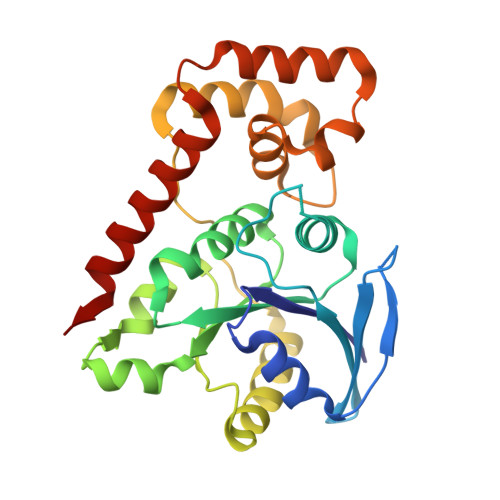Structural determinants of Vibrio cholerae FeoB nucleotide promiscuity.
Lee, M., Magante, K., Gomez-Garzon, C., Payne, S.M., Smith, A.T.(2024) J Biol Chem 300: 107663-107663
- PubMed: 39128725
- DOI: https://doi.org/10.1016/j.jbc.2024.107663
- Primary Citation of Related Structures:
8VWL, 8VWN, 9BA6, 9BA7 - PubMed Abstract:
Ferrous iron (Fe 2+ ) is required for the growth and virulence of many pathogenic bacteria, including Vibrio cholerae (Vc), the causative agent of the disease cholera. For this bacterium, Feo is the primary system that transports Fe 2+ into the cytosol. FeoB, the main component of this system, is regulated by a soluble cytosolic domain termed NFeoB. Recent reanalysis has shown that NFeoBs can be classified as either GTP-specific or NTP-promiscuous, but the structural and mechanistic bases for these differences were not known. To explore this intriguing property of FeoB, we solved the X-ray crystal structures of VcNFeoB in both the apo and the GDP-bound forms. Surprisingly, this promiscuous NTPase displayed a canonical NFeoB G-protein fold like GTP-specific NFeoBs. Using structural bioinformatics, we hypothesized that residues surrounding the nucleobase could be important for both nucleotide affinity and specificity. We then solved the X-ray crystal structures of N150T VcNFeoB in the apo and GDP-bound forms to reveal H-bonding differences surrounding the guanine nucleobase. Interestingly, isothermal titration calorimetry revealed similar binding thermodynamics of the WT and N150T proteins to guanine nucleotides, while the behavior in the presence of adenine nucleotides was dramatically different. AlphaFold models of VcNFeoB in the presence of ADP and ATP showed important conformational changes that contribute to nucleotide specificity among FeoBs. Combined, these results provide a structural framework for understanding FeoB nucleotide promiscuity, which could be an adaptive measure utilized by pathogens to ensure adequate levels of intracellular iron across multiple metabolic landscapes.
Organizational Affiliation:
Department of Chemistry and Biochemistry, University of Maryland, Baltimore County, Baltimore, Maryland, USA.
















